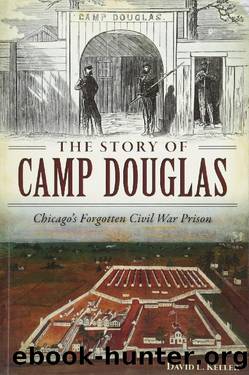The Story of Camp Douglas: Chicago's Forgotten Civil War Prison by David Keller

Author:David Keller [Keller, David]
Language: eng
Format: epub
Tags: History, United States, Civil War Period (1850-1877), State & Local, Midwest (IA; IL; IN; KS; MI; MN; MO; ND; NE; OH; SD; WI), True Crime, General
ISBN: 9781626199118
Google: 2OLJBgAAQBAJ
Amazon: 1626199116
Publisher: Arcadia Publishing
Published: 2015-03-23T00:00:00+00:00
Men catching rats at Point Lookout Prison. Maryland Historical Society.
The recommended diet, both in the North and South, was 2,325 calories, 75.5 grams of protein and 77.5 grams of fat for garrison troops per day. Authorized prisoner rations provided a range from 1,400 to 3,000 calories, 30.0 to 245.0 grams of fat and 40.0 to 165.0 grams of protein, depending on the alternatives provided. The authorized diet failed to provide an adequate amount vitamins and minerals, except for niacin. These deficiencies, principally the lack of fruits and vegetables, contributed to incidents of disease in the camp. The diets and its deficiencies were similar to those of non-prisoners. Diet-related diseases such as dysentery and diarrhea were the leading killers in the Civil War.352
One disease that could have been avoided was scurvy. While only thirty-nine deaths resulted from the 3,745 cases treated at the Camp Douglas hospital,353 some of those treated and released undoubtedly died of other causes as a result of the effects of scurvy. In August 1864, Colonel Sweet requested approval for the sutlers to sell vegetables because of the increase in scurvy cases. That October, Colonel Hoffman refused to reverse his decision that sutlers were prohibited to sell vegetables and suggested to Colonel Sweet that he reduce the meat ration to pay for vegetables or use the prison fund for that purpose.354 Records lack any justification for the position taken by Colonel Hoffman, as vegetables were readily available in Chicago.
While ration quality and quantity varied greatly at Camp Douglas, prisoners usually received food that met the âplain and wholesome food, whenever practicableâ standards of General Order 100.
PRISONER CLOTHING
In addition to the quality and quantity of food, inadequate clothing and bedding were major issues for prisoners at Camp Douglas. The butternut uniforms issued by the Confederacy were not designed to protect prisoners from the Chicago winter. Like all soldiers before and after the Civil War, heavy and unwanted equipment, from overcoats to shelter gear, was often abandoned in the march to and during the conduct of battles. Confederate soldiers at Fort Donelson and Nashville typically shared this âtravel lightâ attitude. Even before the battle at Franklin, Tennessee, in November 1864, Copley observed, âMany soldiers were barefoot, and their clothing very ragged.â In Nashville, after being captured, he noted, âBut few of this little crowd wore shoes or boots, the majority of them being barefooted, and had been for some time previous, and not many of us wore anything except outside clothing. In the warm climate of the South, some two years prior to this, the Army of Tennessee had dispensed with such unnecessary luxuries, for the reason that the Confederate States Government was financially unable to furnish that class of clothing to its soldiers.â355
The first prisoners arriving from Fort Donelson were described thusly: âMany of them have no overcoats at all and supply their place with horse blankets, hearth rugs, coverlids, pieces of carpet, coffee sacks, etc. etc. Many looked pale and actually had attacks of ague chills as they stood awaiting the preparation of their barracks.
Download
This site does not store any files on its server. We only index and link to content provided by other sites. Please contact the content providers to delete copyright contents if any and email us, we'll remove relevant links or contents immediately.
In Cold Blood by Truman Capote(3306)
The Innovators: How a Group of Hackers, Geniuses, and Geeks Created the Digital Revolution by Walter Isaacson(2834)
Steve Jobs by Walter Isaacson(2831)
All the President's Men by Carl Bernstein & Bob Woodward(2327)
Lonely Planet New York City by Lonely Planet(2171)
And the Band Played On by Randy Shilts(2129)
The Room Where It Happened by John Bolton;(2102)
The Poisoner's Handbook by Deborah Blum(2090)
The Murder of Marilyn Monroe by Jay Margolis(2058)
The Innovators by Walter Isaacson(2055)
Lincoln by David Herbert Donald(1944)
A Colony in a Nation by Chris Hayes(1880)
Under the Banner of Heaven: A Story of Violent Faith by Jon Krakauer(1746)
Amelia Earhart by Doris L. Rich(1648)
The Unsettlers by Mark Sundeen(1644)
Birdmen by Lawrence Goldstone(1618)
Being George Washington by Beck Glenn(1613)
Dirt by Bill Buford(1611)
Zeitoun by Dave Eggers(1590)
